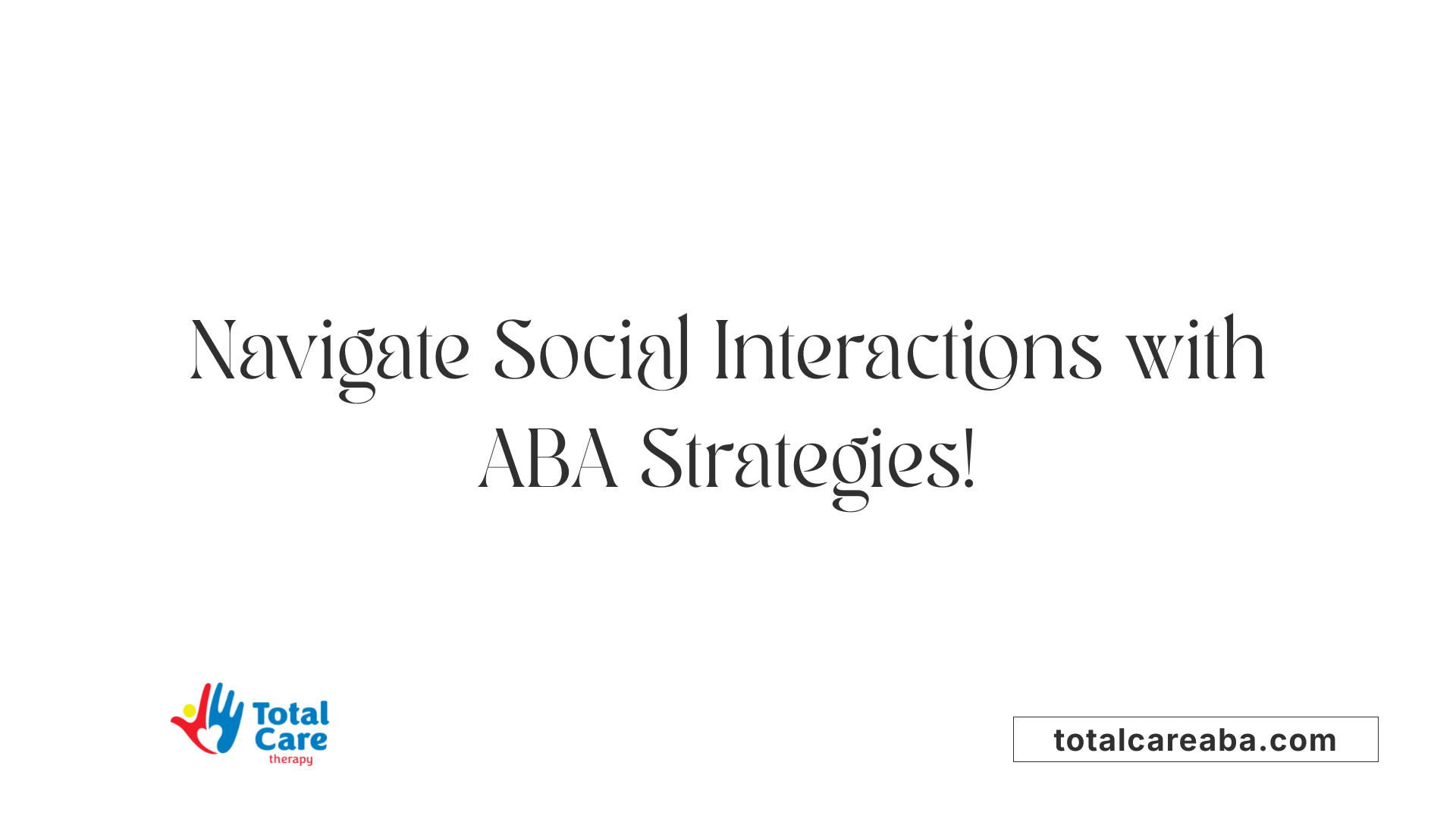Building Social Skills Through ABA
Harnessing ABA to Elevate Social Competence
Building Social Skills Through ABA
The Power of ABA in Developing Social Skills
Applied Behavior Analysis (ABA) plays a crucial role in helping individuals, particularly those with Autism Spectrum Disorder (ASD), develop essential social skills. Through structured interventions, ABA therapy breaks down complex social interactions into manageable steps, facilitating better communication and interaction in various environments. This article explores the methodologies employed in ABA to enhance social engagement, tailor interventions, and ensure success in everyday social contexts.
Understanding the Core Techniques of ABA

Behavioral Skills Training in ABA
Behavioral Skills Training (BST) is an essential method within Applied Behavior Analysis (ABA) focused on teaching social skills. BST utilizes four key components: explanation, modeling, guided practice, and feedback. This systematic approach allows therapists to break down social behaviors into manageable steps, ensuring children learn how to navigate diverse social interactions effectively.
Discrete Trial Training (DTT) and Natural Environment Training (NET)
In addition to BST, Discrete Trial Training (DTT) and Natural Environment Training (NET) play significant roles in ABA therapy. DTT focuses on structured, one-on-one teaching sessions that target specific behaviors. On the other hand, NET emphasizes teaching skills in more natural settings, allowing for real-life application. Combining these methods helps children generalize their social skills across different environments.
Positive Reinforcement as a Central Strategy
Positive reinforcement is a cornerstone of ABA therapy. By rewarding desired behaviors, such as taking turns or initiating conversations, therapists significantly encourage children to repeat those behaviors. Rewards can include verbal praise, stickers, or other incentives, creating a positive learning atmosphere that promotes consistent engagement in social interactions.
Core TechniqueDescriptionImpact on Social SkillsBehavioral Skills Training (BST)Involves explanation, modeling, practice, and feedbackEnhances understanding and execution of social behaviorsDiscrete Trial Training (DTT)Structured learning sessions targeting specific skillsFacilitates focused learning and behavior trackingNatural Environment Training (NET)Teaches skills in real-life contextsPromotes the ability to generalize skills across settingsPositive ReinforcementRewards desired behaviors to encourage repetitionIncreases motivation and promotes long-term behavior change
How does ABA improve social skills?
ABA improves social skills by teaching individuals how to effectively communicate and interact with others, both verbally and non-verbally. The therapy is tailored to each person's unique strengths and needs, focusing on individualized skill development, including understanding social cues and forming friendships. Techniques like the Early Start Denver Model and Pivotal Response Treatment emphasize child-led, natural interactions, making social learning more engaging. Additionally, ABA helps identify triggers for harmful behaviors and teaches alternative responses, fostering a safer social environment. While effective for many, ABA's implementation must be approached with care, ensuring it aligns with the individual’s personal experiences and needs.
Targeted Social Skills in ABA Programs

The Range of Social Skills Taught
Applied Behavior Analysis (ABA) programs focus on an array of social skills designed to support individuals, particularly children with autism spectrum disorder (ASD), in navigating social interactions effectively. Commonly taught skills include:
Skills Essential for Children with Autism
Children on the autism spectrum often encounter unique challenges in social interactions. Thus, ABA therapy emphasizes foundational social skills that are critical for their social development, such as:
Through these targeted skills, ABA therapy promotes meaningful relationships and enhances communication, ultimately improving the quality of life for children with autism.
Which interventions improve social skills in autistic people?
Interventions for improving social skills in autistic people encompass a range of strategies including Naturalistic Language Strategies, Social Narratives, Video Modeling, and Functional Communication Training. Augmentative and alternative communication (AAC) methods, such as Picture Exchange Communication System (PECS) and Voice Output Communication Aids (VOCA), can be particularly beneficial for those with limited verbal skills. Moreover, personalized assessments conducted by speech-language pathologists (SLPs) allow for tailored approaches to address individual communication challenges, facilitating social interaction. Early intervention remains crucial, as starting at a young age can significantly enhance social and verbal abilities over time. Additionally, fostering inclusive environments and providing training in various settings, such as theater and education, can further improve social engagement for individuals with autism.
Navigating Social Settings through ABA

Addressing challenges faced by individuals with autism
Children on the autism spectrum often struggle with social interactions, which includes difficulties in recognizing social cues, initiating conversations, and maintaining eye contact. These challenges can significantly hinder their ability to develop meaningful relationships and interact confidently within various social settings.
Applied Behavior Analysis (ABA) therapy is designed to address these gaps systematically. Using techniques like positive reinforcement, social stories, and role-playing, ABA therapists help individuals with autism learn essential social skills. For instance, through structured interventions, children practice scenarios that require them to engage in turn-taking or share their thoughts during conversations.
The importance of structured interventions
Structured interventions are crucial in the development of social skills among children with autism. ABA therapy employs a methodical approach to break down complex behaviors into smaller, manageable components. This includes teaching specific skills such as understanding body language, expressing empathy, or recognizing emotional cues.
Individualized goal setting ensures that each child’s therapy is tailored to their unique challenges and strengths. Moreover, using tools like the Assessment of Basic Language and Learning Skills (ABLLS) enables therapists to track progress effectively, reassess goals, and adapt strategies as needed.
What is the social learning theory in ABA?
Albert Bandura's social learning theory in Applied Behavior Analysis (ABA) emphasizes that observation and modeling are fundamental to the learning process. According to Bandura, individuals can learn behaviors simply by observing the actions of others, rather than relying solely on direct experiences. In his 1977 work, he highlighted that most human behavior is learned observationally through the process of modeling. This learning process involves four key components: attention, retention, reproduction, and motivation, which are necessary for effective observation and learning. Overall, the theory illustrates how social environment and interaction influence individual learning and behavior.
Individualized Assessments and Goal Setting in ABA

Pre-and post-assessments for progress tracking
In Applied Behavior Analysis (ABA), pre-and post-assessments are pivotal for determining a child's existing social skills and establishing targeted objectives for improvement. These assessments provide clarity on the specific areas where the child struggles, facilitating a tailored approach in therapy. By measuring progress over time, therapists can ensure that interventions remain effective and relevant, adjusting strategies as needed to maximize learning outcomes.
Tailored goal setting based on individual needs
Goal setting in ABA is highly individualized, reflecting each child's unique strengths and challenges. Behavioral objectives must be specific, observable, and measurable to track progress effectively. This approach allows therapists to align interventions with age-appropriate benchmarks. Key skills often targeted include initiating conversations, recognizing social cues, and expressing emotions. These goals foster not only skill acquisition but also confidence, enhancing the child’s ability to navigate social situations.
What is the ABA code for social skills groups?
The ABA code for social skills groups is CPT code 97158, which is used for group adaptive behavior treatment that includes protocol modification. This code applies when a provider delivers adaptive behavior treatment to multiple patients within a group setting. It was introduced on August 1st, 2021, along with CPT code 97157, which is designated for multiple family group adaptive behavior treatment guidance. Code 97157 allows up to 8 families to receive treatment guidance over approximately 1.5 hours. Understanding these codes is essential for providers and practitioners, as they play a critical role in billing and insurance reimbursement for ABA therapy services.
The Impact of ABA on Social Engagement

Long-term benefits and improvements in social skills through ABA
Applied Behavior Analysis (ABA) is particularly beneficial for individuals with autism spectrum disorder (ASD), offering targeted social skills training that leads to significant, long-lasting improvements. Research shows that children receiving intensive ABA therapy—ideally over 20 hours a week—can demonstrate important developmental gains in social skills as early as their first few years. These gains can include better communication, enhanced social interactions, and improved emotional understanding. Many children show reduced need for additional special services later in life as a result of the foundational skills learned through ABA.
Strategies for generalizing skills across contexts
To ensure the skills acquired in therapy translate to real-world scenarios, ABA employs various techniques for generalization. Role-playing, for instance, allows children to practice social interactions in a controlled environment before applying them in more spontaneous settings. Prompting and positive reinforcement further encourage the use of learned behaviors in diverse contexts. Visual aids, such as social stories and cue cards, enhance understanding of social cues and expectations, facilitating their application across different social situations. By targeting specific deficits through individualized goals, therapists ensure that skills are relevant and adaptable to various environments.
Concluding Thoughts on ABA’s Role in Social Skill Development
ABA therapy offers a comprehensive and evidence-based approach to enhancing social skills in individuals with autism, focusing on the unique needs and strengths of each person. By systematically teaching social behaviors and utilizing reinforcement strategies, ABA provides individuals with the tools necessary to navigate social environments confidently. As research continues to support its effectiveness, ABA remains a vital resource for fostering meaningful social interactions and improving the quality of life for those with ASD.








